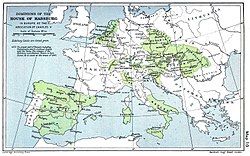Southern Netherlands
The Southern Netherlands,[1] also called the Catholic Netherlands, were part of the Low Countries. They were controlled by Spain (1556–1714), Austria (1714–94) and added into France (1794–1815). This area was most of modern Belgium, the Imperial Abbey of Stavelot-Malmedy, the County of Bouillon and Luxembourg, and in addition some parts of the Netherlands, as well as, until 1678, most of the present Nord-Pas-de-Calais region in northern France. The Southern Netherlands were part of the Holy Roman Empire until it was added to France.
The northern seven provinces, led by Holland and Zeeland, started their independence as the United Provinces after 1581. The southern Netherlands were reconquered by the Spanish general Alexander Farnese, Duke of Parma. The Southern Netherlands passed to the Austrian Habsburgs after the War of the Spanish Succession in the early 18th century. After the French Revolutionary Wars they were joined with the northern Netherlands. They were made a single kingdom under the House of Orange at the 1815 Congress of Vienna. The south-eastern third of Luxembourg Province was made into Luxembourg. In 1830 the mostly Roman Catholic southern half became independent as the Kingdom of Belgium.
Southern Netherlands Media
A map of the dominion of the Habsburgs following the Battle of Mühlberg (1547) as depicted in The Cambridge Modern History Atlas (1912); Habsburg lands are shaded green. From 1556 the dynasty's lands in the Low Countries, the east of France, Italy, Sardinia, and Sicily were retained by the Spanish Habsburgs.
Silver florin of Emperor Charles V with the coat of arms of the House of Burgundy (Low Countries, etc.) c. 1553.
Velázquez portrait of the Cardinal-Infante Ferdinand, son of Philip III of Spain, Governor General of the Low Countries at age 25, in 1634, until his death in 1641.
References
- ↑ (Dutch: Zuidelijke Nederlanden, Spanish: Países Bajos del Sur, French: Pays-Bas méridionaux)





